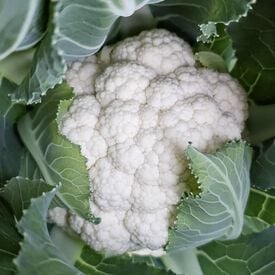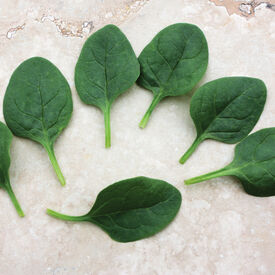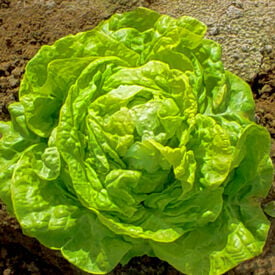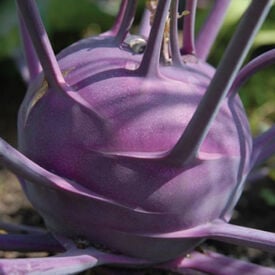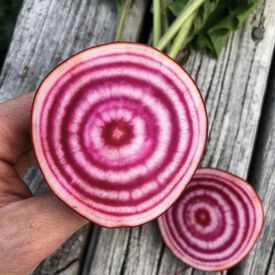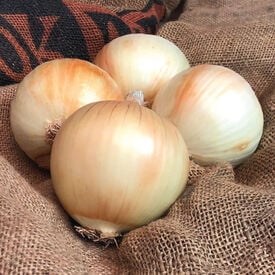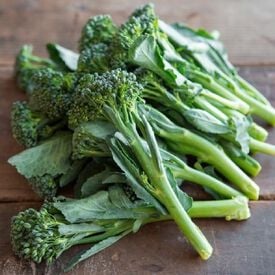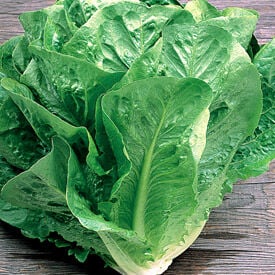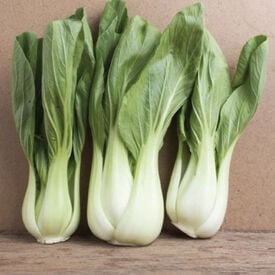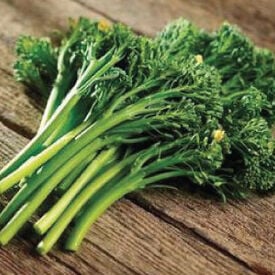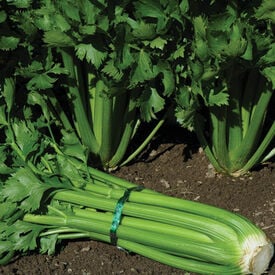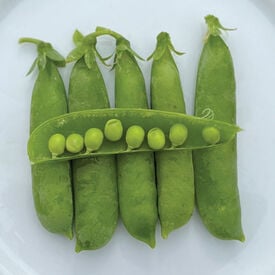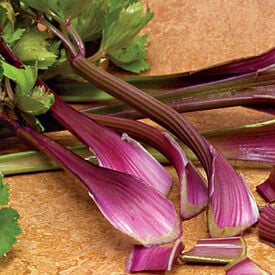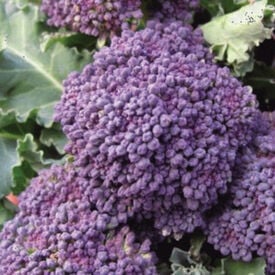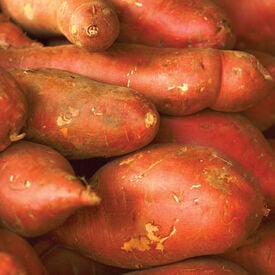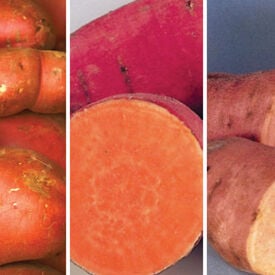Snowball Y Improved cauliflower is a popular open pollinated variety! This cauliflower is known for its vigorous, rapid growth and long harvest. Its head is snow-white and measures 7-8" inches across. Give this cauliflower fertile soil, full sun and steady moisture and you'll be rewarded with large, delicious heads that are high in vitamin C.
Seaside produces very uniform and great tasting baby leaf spinach. Stays baby size for extended period of time extending the season. Seaside has a nice, smooth, thick, very dark green, spade-shaped leaf making it a perfect choice for baby leaf growers. Seaside has great downy mildew resistance.
White Boston lettuce seeds produce an old heirloom butterhead variety known since the early 1900s for its soft, tender texture and reliable garden performance. The plants form loose, pale-green heads with broad, silky leaves that have a mild, buttery flavor and a pleasantly delicate crunch. This variety prefers cool weather, making it ideal for spring and fall planting, and thrives in rich, well-drained soil with consistent moisture. To grow it successfully, sow seeds shallowly, keep the soil evenly moist, provide partial shade in warmer climates to prevent bolting, and harvest heads when they are full and firm for the best flavor and texture.
The Purple Vienna Kohlrabi is an early variety that grows to 12" inches high. The pale purple, flattened, globe shaped bulbs are smooth and tender and form above the ground. Purple Vienna's uniquely flavored white flesh tastes the best when its bulbs are 3" in diameter. Sow in the spring to enjoy a successful harvest over a longer period of time.
Chioggia beets, also known as Candy Cane or Bull's Eye beets, are a unique and visually striking variety of beets that originated in Italy. Their history dates back to the early 19th century when they were first cultivated in the coastal town of Chioggia, near Venice. These beets are renowned for their vibrant and eye-catching appearance, characterized by concentric rings of alternating red and white colors, reminiscent of a candy cane. This distinct coloration makes them a popular choice among gardeners and chefs for their ornamental and culinary appeal. In terms of taste, Chioggia beets offer a mild and slightly sweet flavor, making them a versatile ingredient in various dishes. They can be enjoyed raw in salads, pickled, roasted, or boiled, and their taste becomes sweeter when cooked. Typically, Chioggia beets are round to slightly flattened in shape, with a diameter of 2 to 3 inches. They are known for their relatively quick maturity, taking around 50 to 60 days to reach full size. Their unique coloration is retained even after cooking, making them a visually stunning addition to any meal. When it comes to growing Chioggia beets, they thrive in well-drained soil with a neutral pH and require full sun for optimal growth. Proper spacing is essential to allow room for their roots to develop, typically requiring 3 to 4 inches between each plant and rows spaced about 12 to 18 inches apart. Chioggia beets are relatively disease-resistant, with a natural ability to withstand some common beet diseases, but it's still essential to monitor them for any signs of issues. With proper care, Chioggia beets can yield a bountiful crop, and their unique appearance and delightful taste make them a favorite among gardeners and culinary enthusiasts alike.
c It also has the Celebrate plant structure to give it an extra boost against stress and make it grower friendly. These qualities help to make it a good fit for a short day program. Disease Ratings: High Tolerance to Pink Root, Fusarium, and Bolting.
De Cicco broccoli, known for its exceptional taste, is a popular heirloom variety of broccoli (Brassica oleracea) that hails from Italy. This Italian heirloom has been cultivated for generations, making it a favorite among gardeners and chefs alike. De Cicco broccoli is classified as a compact, semi-dwarf type of broccoli, and it is highly prized for its versatility in the kitchen and its relatively quick maturity. De Cicco broccoli boasts a mild, slightly sweet flavor with a hint of nuttiness. Its tender, dark green florets are surrounded by a profusion of lush leaves. The compact plant typically reaches a height of 18-24 inches, making it suitable for smaller gardens or container growing. De Cicco is known for its relatively short days to maturity, typically taking around 48-65 days from seed sowing to harvest. This broccoli variety is characterized by its vibrant, dark green color, which is indicative of its high nutrient content. De Cicco broccoli exhibits strong disease resistance, particularly against common broccoli ailments like downy mildew and clubroot, which can be a relief for growers. When properly cared for, De Cicco broccoli can yield a bountiful harvest of small to medium-sized heads, often producing side shoots after the main head is harvested. For optimal growth, it's recommended to sow De Cicco broccoli seeds in well-drained soil with full sun exposure. Plant the seeds 1/4 to 1/2 inch deep, spacing them about 18-24 inches apart to provide enough room for the plants to mature and thrive. Additionally, consistent watering and adequate fertilization can help ensure a successful De Cicco broccoli crop.
Strawberry Spinach is a delicious fruit that is almost entirely edible. A beautiful plant with showy leaves and berries. It's triangular toothed leaves and tender shoots are great for salads. Shiny red mulberry-like fruits are edible and can be added to salads. Grown in Europe for centuries.
The Green Towers Lettuce is an easy to grow, tasty green leaf lettuce. This lettuce variety offers a mild flavor with an attractive semi-savoyed texture. The Green Towers is a favorite for its adaptability and dense habit! This lettuce will grow great in any climate!
White Stem Pak Choi, also known as Bok Choy or Pak Choi, is a versatile and popular Asian cabbage variety with origins in China. This leafy green vegetable has been cultivated for centuries, appreciated for its tender leaves and crisp, white stems. Characterized by its vibrant green, broad leaves and smooth, white stalks, White Stem Pak Choi is both visually appealing and nutritious. The flavor is mild and slightly sweet, making it a popular choice in stir-fries, soups, and salads. Harvesting typically occurs 45-60 days after planting, when the plants reach a height of about 12-18 inches, and can be done by cutting the entire plant or picking individual leaves. White Stem Pak Choi thrives in cooler weather, preferring well-drained soil and full sun, making it suitable for spring and fall planting. Its rapid growth and ability to produce multiple harvests, combined with its rich content of vitamins A, C, and K, make it a favorite among gardeners and cooks alike. Overall, White Stem Pak Choi is valued for its crisp texture, mild flavor, and adaptability in a variety of dishes.
Aspabroc broccoli seeds grow into a unique hybrid vegetable developed in the early 1990s by crossing standard broccoli with a Chinese kale-gai lan variety, resulting in what’s often called “broccolini.” This plant produces slender, tender stems topped with small, loose florets that resemble asparagus in shape, hence the name. Aspabroc is prized for its sweet, mild flavor with subtle peppery notes, making it delicious whether steamed, sautéed, stir-fried, or grilled. It thrives in cool-season conditions, preferring full sun and fertile, well-drained soil, with harvests ready in about 50–60 days after transplanting. Known for its extended harvest period, plants continue producing side shoots after the main head is cut, giving gardeners a steady supply. Its unique history, high nutritional value, and gourmet quality make Aspabroc a popular choice for home growers and chefs alike.
Tall Utah celery, developed in the early 20th century in Utah, is renowned for its tall, sturdy stalks and exceptional flavor. This variety features vibrant green, crisp stalks that can reach heights of 18-36 inches, making it a standout in gardens. The taste is mild and slightly sweet, perfect for fresh eating or cooking in a variety of dishes. Harvesting typically occurs 85-100 days after planting, when the stalks are firm and well-developed; gardeners can choose to cut the entire plant or selectively harvest individual stalks as needed. Tall Utah celery thrives in cool climates and requires consistent moisture, making it a favorite for both home growers and commercial producers.
The Little Marvel Pea is a well known old time home garden favorite, that is really a marvel! This pea is an excellent choice selected for its high yield potential and excellent sweet flavor making it the most satisfactory pea in the home garden. This variety's plants are very productive and compact and will grow up to 30" tall. Little Marvel produces small bright green pods with luscious, sugary peas that stay tender and sweet even when fully ripe!
The large, red stalks of the Giant Red celery have a wonder flavor, some prefer it over green stalks! The Giant Red celery is a hidden gem. This variety is by far the best tasting celery you can grow! The yellow-pink hearts of the Giant Red are great in salads or soup and it grows great throughout the United States.
The Early Purple Sprouting broccoli is an heirloom broccoli bred for overwintering! This variety produces lots of beautiful purple broccoli sprouts in the spring. The Early Purple Sprouting grows slowly through the winter; very frost hardy.
Certified - Georgia Jets is such a fast growing sweet potato! This sweet potato is a marvelous variety that just like its name suggests, matures extremely fast! In 90 days you will have large, ready to eat sweet potatoes. Georgia Jets is also high yielding!
Enjoy a mouth watering blend of the Sweet Potato Mix! This mix contains all 3 of the sweet, delicious sweet potato varieties that we carry, the Georgia Jets, Beauregard and Centennial. Not sure which variety to buy? Try all 3!
Minowase radish seeds produce a classic Japanese daikon variety with origins in East Asia, where long-rooted radishes have been cultivated for centuries for their productivity and versatility. Known for its smooth white roots that often reach 12–18 inches, Minowase features crisp, juicy flesh with a mild, slightly sweet, lightly peppery flavor that is far gentler than smaller spring radishes. Its clean taste and firm texture make it ideal for microgreens, sprouts, salads, pickling, stir-fries, soups, fermenting, and even grating fresh as a condiment. This variety grows best in cool weather and loose, deeply prepared soil that allows for long, straight roots; sow seeds directly in late summer or early fall, provide consistent moisture, thin seedlings to prevent crowding, and harvest before hard frosts for the best quality.
